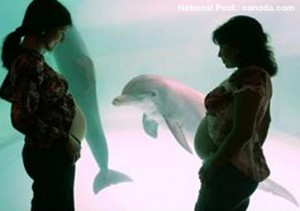Raw Food TV - Click to see
Blog Archive
-
▼
2011
(70)
-
▼
September
(8)
- The power of Vitamin D - And yes you can get it fr...
- Plants can recognize rivals and fight, study says
- 10 Naughtiest Vegetables on Earth
- Humanity falls deeper into ecological debt: study
- 40 years Greenpeace !!!
- Dolphin Midwives and Underwater Birthing
- Rawfood Workshop
- Doctors know nothing about nutrition
-
▼
September
(8)
Followers
Add me on Facebook
Donations Welcome!!!
Wednesday, September 7, 2011
Dolphin Midwives and Underwater Birthing
 Igor Charkovsky, a Russian male mid-wife has assisted in over 20,000 underwater births, but in 1979 he began experiments with dolphins and children. His daughter, one of the first modern water-birthers, was in her late twenties when the following incident happened. Charkovsky and his team had taken a woman to the Black Sea in Israel for an underwater birth. In two feet of water, preparing for the birth, suddenly three dolphins approached, pushed everyone out of the way and took over. They scanned the length of her body (with sonar?), which somehow relaxed the mother and child and gave birth with no pain or fear. Apparently all the human midwives were pretty shocked though. This opened up the new practice of ‘Dolphin mid-wivery’ which may sound strange, but fits in with the new breed of super-children that are currently coming in to existence.
Igor Charkovsky, a Russian male mid-wife has assisted in over 20,000 underwater births, but in 1979 he began experiments with dolphins and children. His daughter, one of the first modern water-birthers, was in her late twenties when the following incident happened. Charkovsky and his team had taken a woman to the Black Sea in Israel for an underwater birth. In two feet of water, preparing for the birth, suddenly three dolphins approached, pushed everyone out of the way and took over. They scanned the length of her body (with sonar?), which somehow relaxed the mother and child and gave birth with no pain or fear. Apparently all the human midwives were pretty shocked though. This opened up the new practice of ‘Dolphin mid-wivery’ which may sound strange, but fits in with the new breed of super-children that are currently coming in to existence.For some reason, dolphins are attracted to pregnant women and young children and as most people are aware, the dolphins can also help heal people with mental and psychological problems. But the children, who are being born with the aid of dolphins, at least with the cases documented in Russia, are extraordinary children. Most of the have IQ’s of over 150 (genius range again), plus extremely stable emotional bodies and strong physical bodies. They are superior in one way or another.
The below video shows a dolphin assisting a mother in giving birth underwater
There are videos that document these babies and children up to age three, sleeping on the bottom of swimming pools. They even come up for air whilst still asleep and turn their heads over the surface of the water, take a breath, then go back to the bottom. It is as though this is their natural home.Some people call them ‘Homodolphinus’ , because they seem to have the characteristics of humans and dolphins. Water is becoming their natural environment, plus they are also super intelligent.
There is ample evidence that humans once had a much more intrinsic connection with water. Charkovsky believes that mans close affinity with aquatic animals can be explained by our common origins in water in our mammalian history. In the book The Aquatic Ape, Elaine Morgan gives a fascinating account of the aquatic theory of evolution. According to Morgan, our aquatic affinity goes back millions of years to the Pilocene age, when our ape ancestors lived a semi-aquatic life on the coastline to escape the extreme heat which occurred due to climatic change. By wading in the sea, our ancestors began to walk upright and lost their body hair and developed a layer of sub-cutaneous fat like other aquatic mammals, to protect them from the cooler temperatures of the water. Today, we still have this layer of sub-cutaneous fat.
Subscribe to:
Post Comments (Atom)


0 comments:
Post a Comment